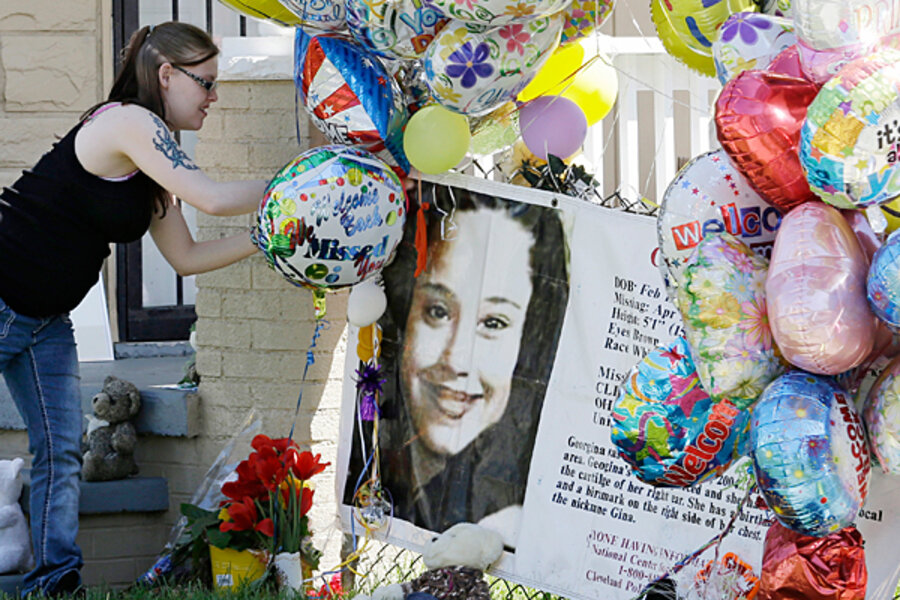Cleveland kidnappings: what abductions should teach worried parents
Loading...
New details in the Cleveland kidnapping case reveal how Ariel Castro allegedly kidnapped three young women, two of whom he did not know and one who was his daughter’s friend.
The scenario portrayed in the documents filed Thursday in Cleveland Municipal Court is a familiar nightmare for parents, involving the seemingly innocent offer of an unplanned ride to a young person by an adult male, whether a stranger or acquaintance.
According to the documents filed in court, Ariel Castro offered Michelle Knight, Amanda Berry, and Gina DeJesus rides home on separate occasions between 2002 and 2004. Instead of taking them home, he took them to his house on Seymour Avenue where he kept them captive until this week, a period ranging from 9 to 11 years.
With all the media attention on the case, child experts say this is an opportunity for parents to talk to their children about what to do if someone attempts to abduct them.
"Every parent needs to have age-appropriate conversations with their children about their safety to-and-from school, at school, and in the community,” said Kenneth Trump, president of the National School Safety and Security Services, in a statement Wednesday. “Whether they are five or 15, we should not assume that children know the seriousness of potential threats or know what to do if they are confronted.”
Michelle Knight, who was 21 when she went missing on Aug. 22, 2002, told police that Castro offered her a ride home as she was walking on Cleveland’s Lorain Avenue. Instead of taking her home, he allegedly brought her to his house where he locked her up in the basement, the police affidavit said.
Amanda Berry had just finished her shift at Burger King on April 21, 2003, when Castro offered her a ride home. He told her that his son also worked at Burger King. Ms. Berry, 16 at the time, called her parents to tell them she was getting a ride home.
Georgina DeJesus knew Castro before she was abducted at age 14. She was friends with Castro’s daughter, whom she had been walking home with on April 2, 2004. Castro approached Ms. DeJesus after the two girls parted paths and offered her a ride to his house so she could hang out with his daughter, the report said.
Nonfamily abductions are rare, representing an “extremely small portion” of missing children, according to the US Justice Department's most recent report on missing children published in 2002.
These kidnappings involve a stranger or acquainteance who detains a child overnight, transports them more than 50 miles, holds them for ransom, or intends to keep them permanently or kill them, the report said. These type of abductions often receive the most media attention.
Parents should talk with their kids about how to be aware of their environment and how to recognize potentially dangerous situations, said Rebecca Baily, a pshychologist who worked with former abductee Jaycee Dugard, in an interview with Time magazine.
She said, “we have [talked to] middle school groups, and it’s unbelievable how many kids in the classrooms will have experienced a scary event and not talk to their parents about it – whether they’ve been followed home by somebody as they were walking home from school or walking to the store. [The scary event] may be as innocuous as a teenager shouting at them, or it could be as sinister as somebody offering them a ride.”
The whole point is to address the fear involved with these topics, for both parents and children, she added.
Teaching children about safety and how to react in these situations helps protect kids, the National Center for Missing and Exploited Children said in their 2011 annual report.
[Editor's notes: The original version of this story incorrectly paraphrased the NCMEC annual report.]
“Children escape attempted abductions 81 percent of the time through their own actions; 28 percent actively resisted by yelling, kicking, pulling away, running away, or attracting attention; and 53 percent recognized something was not right and responded by walking or running away,” the report said.
In her forthcoming book, “Safe Kids, Smart Parents,” Bailey writes that there is a rising number of children who have been able to escape from abductors, and it shows children that “escape is a real option.”
Berry proved this with her escape from Castro’s house Monday night.
"The situation has turned,” assistant prosecuting attorney Brian Murphy said During Castro’s arraignment hearing Thursday. “Castro is the captive in captivity."








